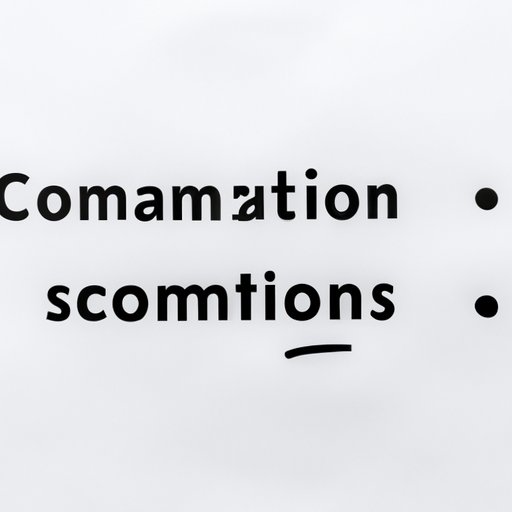
Introduction
When it comes to writing, the use of semicolons can make a world of difference in clarity and coherence. However, many writers struggle with knowing when and how to use them properly. In this article, we’ll explore the importance of semicolons and provide a comprehensive guide to using them effectively.
The Rule of Semicolons: When to Use Them and Why
Semicolons are a type of punctuation that can be used to join two independent clauses that are closely related in meaning. Unlike commas, semicolons provide a stronger connection between the two ideas. For example:
“She loves to dance; he prefers to sing.”
In this sentence, each clause could stand alone as its own sentence, but the semicolon helps to emphasize the relationship between the two ideas.
Another use of semicolons is between items in a list when the items themselves contain commas. This is commonly known as the Oxford comma or serial comma. For example:
“I need to buy bread, milk, and cheese; oranges, bananas, and apples; and eggs.”
Semicolons can also be used to separate complex items that already contain commas, such as in a list of names or addresses. For example:
“We visited Berlin, Germany; Prague, Czech Republic; and Vienna, Austria on our trip.”
Mastering the Art of Punctuation: An In-Depth Guide to Semicolons
To use semicolons effectively, it’s important to understand the context in which they are used. In technical writing, semicolons are often used to clarify complex ideas or to set off technical terms. In academic writing, semicolons can be used to show the relationship between two related ideas in a single sentence. In creative writing, semicolons can be used to create a sense of flow or to add emphasis to a particular idea.
To avoid common mistakes when using semicolons, it’s important to remember that they cannot be used to join a dependent clause to an independent clause. For example:
“Although she was tired; she stayed up late.”
This sentence is incorrect because “although she was tired” is a dependent clause and cannot stand alone as a sentence.
Breaking Down the Semicolon: A Beginner’s Guide to Using It Correctly
If you’re new to using semicolons, here’s a step-by-step approach to using them effectively:
- Identify two independent clauses that are closely related in meaning.
- Punctuate each clause as its own sentence, if necessary.
- Select the semicolon to join the two ideas together.
- Review the resulting sentence to ensure that it maintains coherence and clarity.
Here’s an example of how these steps can be applied:
“The dog barked at the mailman. The cat ran under the couch.”
These two sentences can be joined with a semicolon:
“The dog barked at the mailman; the cat ran under the couch.”
Semicolons 101: An Easy-to-Follow Tutorial for Crafting Effective Sentences
To use semicolons effectively, it’s important to understand their many uses. Here are some tips and tricks for using semicolons in your writing:
- Use semicolons to show a connection between two related ideas.
- Use semicolons when separating items in a complex list.
- Use semicolons to clarify complex or technical concepts.
- Don’t use semicolons to join dependent clauses to independent clauses.
- Don’t use semicolons in place of commas or colons.
Using semicolons for emphasis, cohesion, and clarity can make your writing stronger and more effective.
Navigating Tricky Punctuation: How to Make the Most of Semicolons in Your Writing
One of the challenges of using semicolons is knowing when they are appropriate and when another form of punctuation would be more suitable. Here are some strategies for using semicolons effectively:
- Consider the context of the sentence and the relationship between the two ideas.
- Read the sentence out loud to ensure that it flows smoothly and makes sense.
- When in doubt, ask a trusted editor or colleague for feedback.
With practice and careful attention to detail, you can become more confident in your use of semicolons in your writing.
Semicolons Made Simple: Tips and Tricks for Using Them with Confidence
To recap, here are the dos and don’ts of using semicolons:
- Use semicolons to join two independent clauses that are closely related.
- Use semicolons in lists when the items themselves contain commas.
- Use semicolons to clarify complex or technical concepts.
- Don’t use semicolons to join dependent clauses to independent clauses.
- Don’t use semicolons as a replacement for commas or colons.
Semicolons can be a powerful tool in your writing arsenal when used correctly and thoughtfully. With practice and attention to detail, you can become more confident in your use of this important punctuation mark.
Conclusion
In conclusion, the use of semicolons can make a significant difference in the clarity and coherence of your writing. By understanding the proper context in which to use them and avoiding common mistakes, you can use semicolons with confidence to create effective and powerful sentences.





